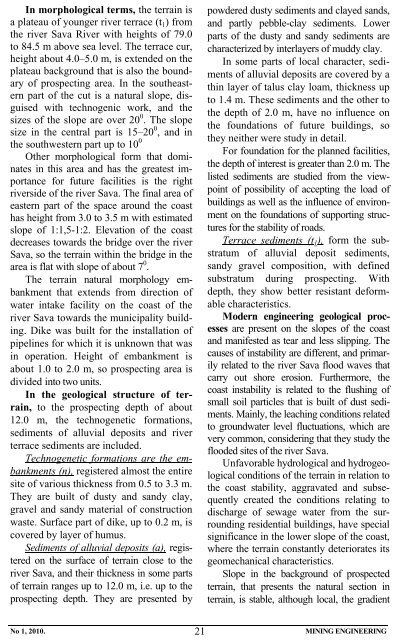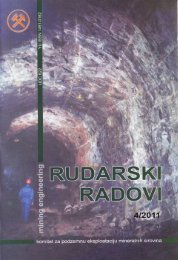Institut za rudarstvo i metalurgiju Bor
Institut za rudarstvo i metalurgiju Bor
Institut za rudarstvo i metalurgiju Bor
Create successful ePaper yourself
Turn your PDF publications into a flip-book with our unique Google optimized e-Paper software.
In morphological terms, the terrain is<br />
a plateau of younger river terrace (t1) from<br />
the river Sava River with heights of 79.0<br />
to 84.5 m above sea level. The terrace cur,<br />
height about 4.0–5.0 m, is extended on the<br />
plateau background that is also the boundary<br />
of prospecting area. In the southeastern<br />
part of the cut is a natural slope, disguised<br />
with technogenic work, and the<br />
sizes of the slope are over 20 0 . The slope<br />
size in the central part is 15–20 0 , and in<br />
the southwestern part up to 10 0<br />
Other morphological form that dominates<br />
in this area and has the greatest importance<br />
for future facilities is the right<br />
riverside of the river Sava. The final area of<br />
eastern part of the space around the coast<br />
has height from 3.0 to 3.5 m with estimated<br />
slope of 1:1,5-1:2. Elevation of the coast<br />
decreases towards the bridge over the river<br />
Sava, so the terrain within the bridge in the<br />
area is flat with slope of about 7 0 .<br />
The terrain natural morphology embankment<br />
that extends from direction of<br />
water intake facility on the coast of the<br />
river Sava towards the municipality building.<br />
Dike was built for the installation of<br />
pipelines for which it is unknown that was<br />
in operation. Height of embankment is<br />
about 1.0 to 2.0 m, so prospecting area is<br />
divided into two units.<br />
In the geological structure of terrain,<br />
to the prospecting depth of about<br />
12.0 m, the technogenetic formations,<br />
sediments of alluvial deposits and river<br />
terrace sediments are included.<br />
Technogenetic formations are the embankments<br />
(n), registered almost the entire<br />
site of various thickness from 0.5 to 3.3 m.<br />
They are built of dusty and sandy clay,<br />
gravel and sandy material of construction<br />
waste. Surface part of dike, up to 0.2 m, is<br />
covered by layer of humus.<br />
Sediments of alluvial deposits (a), registered<br />
on the surface of terrain close to the<br />
river Sava, and their thickness in some parts<br />
of terrain ranges up to 12.0 m, i.e. up to the<br />
prospecting depth. They are presented by<br />
powdered dusty sediments and clayed sands,<br />
and partly pebble-clay sediments. Lower<br />
parts of the dusty and sandy sediments are<br />
characterized by interlayers of muddy clay.<br />
In some parts of local character, sediments<br />
of alluvial deposits are covered by a<br />
thin layer of talus clay loam, thickness up<br />
to 1.4 m. These sediments and the other to<br />
the depth of 2.0 m, have no influence on<br />
the foundations of future buildings, so<br />
they neither were study in detail.<br />
For foundation for the planned facilities,<br />
the depth of interest is greater than 2.0 m. The<br />
listed sediments are studied from the viewpoint<br />
of possibility of accepting the load of<br />
buildings as well as the influence of environment<br />
on the foundations of supporting structures<br />
for the stability of roads.<br />
Terrace sediments (t1), form the substratum<br />
of alluvial deposit sediments,<br />
sandy gravel composition, with defined<br />
substratum during prospecting. With<br />
depth, they show better resistant deformable<br />
characteristics.<br />
Modern engineering geological processes<br />
are present on the slopes of the coast<br />
and manifested as tear and less slipping. The<br />
causes of instability are different, and primarily<br />
related to the river Sava flood waves that<br />
carry out shore erosion. Furthermore, the<br />
coast instability is related to the flushing of<br />
small soil particles that is built of dust sediments.<br />
Mainly, the leaching conditions related<br />
to groundwater level fluctuations, which are<br />
very common, considering that they study the<br />
flooded sites of the river Sava.<br />
Unfavorable hydrological and hydrogeological<br />
conditions of the terrain in relation to<br />
the coast stability, aggravated and subsequently<br />
created the conditions relating to<br />
discharge of sewage water from the surrounding<br />
residential buildings, have special<br />
significance in the lower slope of the coast,<br />
where the terrain constantly deteriorates its<br />
geomechanical characteristics.<br />
Slope in the background of prospected<br />
terrain, that presents the natural section in<br />
terrain, is stable, although local, the gradient<br />
No 1, 2010. 21<br />
MINING ENGINEERING



